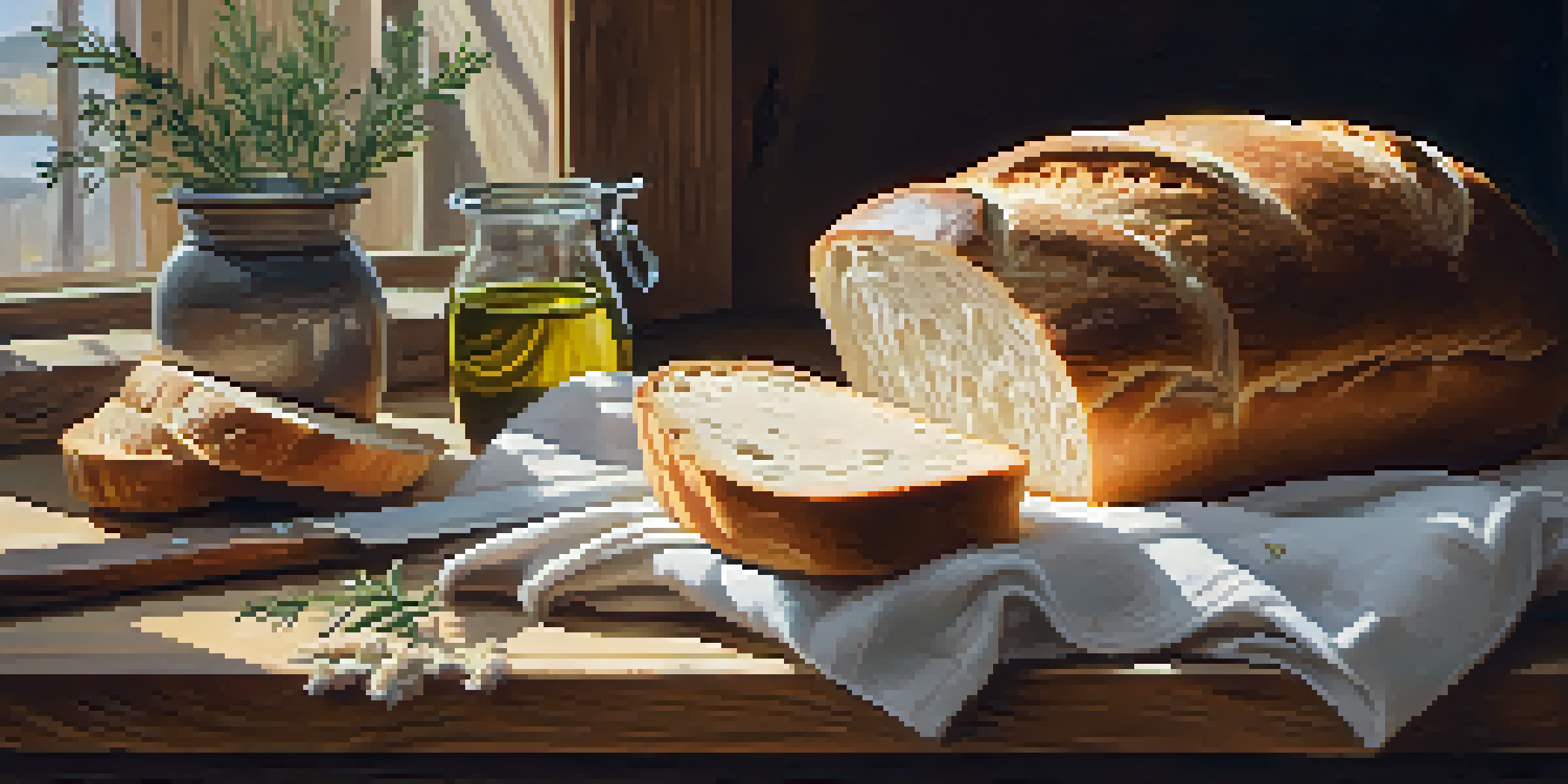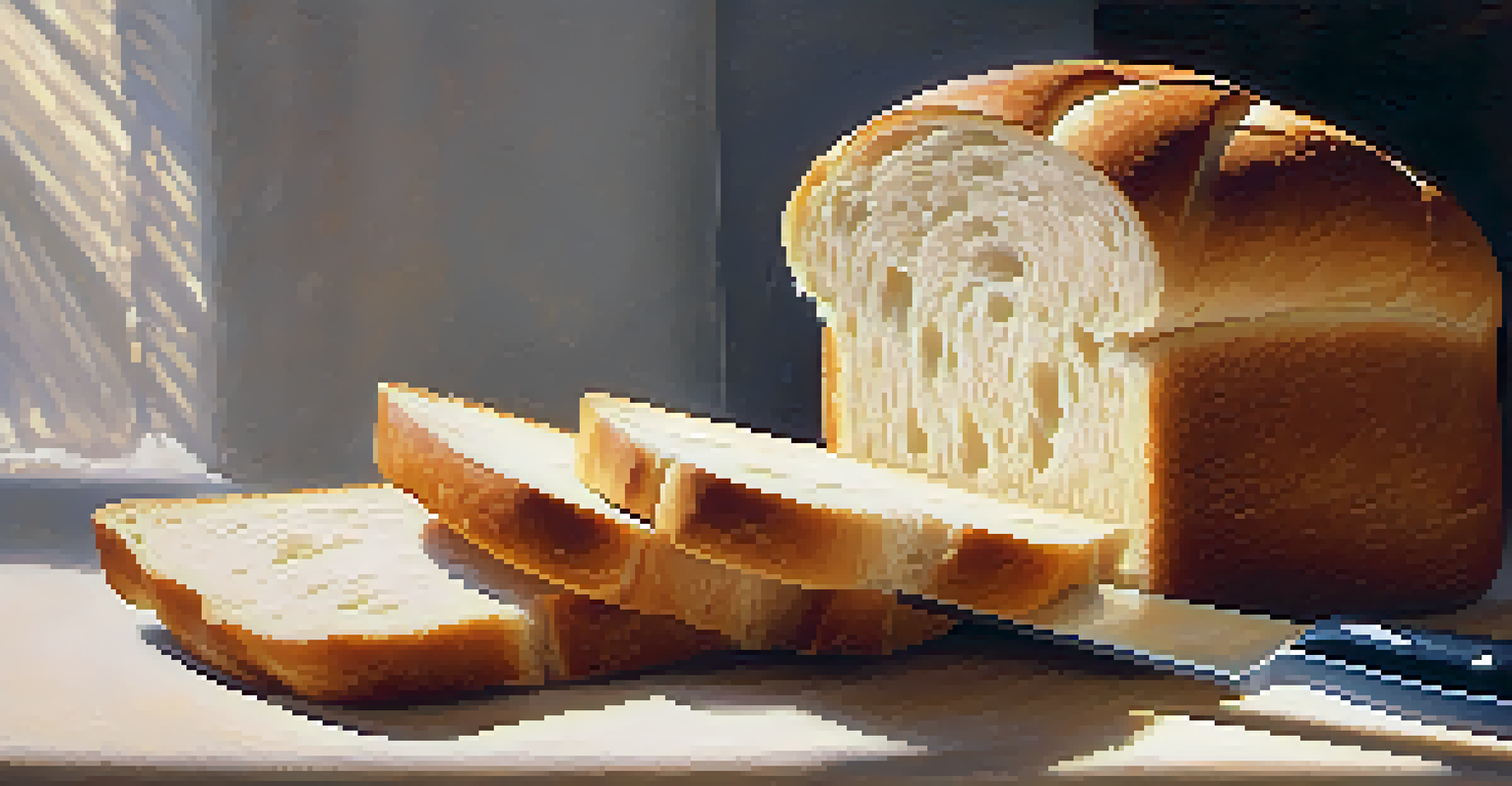Storing Homemade Bread: Tips for Freshness and Longevity

Understanding the Best Storage Practices for Bread
Storing homemade bread properly is essential for maintaining its freshness. The way you store it can affect its texture and flavor, so it's crucial to choose the right method. Whether you're dealing with a crusty artisan loaf or a soft sandwich bread, understanding storage practices will help keep your bread delightful for longer.
Good bread is the most fundamentally satisfying of all foods; and good bread with fresh butter, the greatest of feasts.
Bread is a living product, and it can be affected by moisture and air. If you leave it out on the counter without any cover, it can dry out quickly or become stale. On the flip side, wrapping it too tightly can trap moisture, leading to mold. Finding the balance is key to extending the life of your homemade creation.
To start, you can consider your bread type. Crusty breads are best stored in a paper bag to keep the crust crispy, while softer breads do better in a plastic bag to maintain moisture. Always ensure the bread is completely cooled before storing, as heat can create steam and promote mold growth.
Choosing the Right Container for Bread Storage
Selecting the right container for your homemade bread is crucial for optimal freshness. You can use a bread box, a paper bag, or even a cloth bag. Each option has its benefits and can help maintain the bread's texture and flavor based on your specific needs.

A bread box is a fantastic choice because it allows for air circulation while keeping the bread away from direct light. This helps prevent mold growth and keeps the crust from becoming too soft. If you opt for a paper bag, remember to store it in a cool, dry place to avoid any moisture buildup.
Store Bread to Maintain Freshness
Proper storage methods can significantly extend the freshness and quality of homemade bread.
For those who prefer a more rustic approach, wrapping your bread in a clean kitchen towel can be effective too. This method allows the bread to breathe while still providing some protection from the air. Just be sure to check on it regularly to ensure it doesn't dry out!
When to Refrigerate Homemade Bread (and When Not To)
Refrigeration can be a bit of a double-edged sword when it comes to bread storage. While it can prolong the shelf life of some baked goods, it can also dry out your bread and make it stale faster. Knowing when to refrigerate your homemade bread is key to retaining its delightful qualities.
Bread is the king of the table and all else is merely the court that surrounds the king.
Generally, you should avoid putting homemade bread in the fridge if it’s meant to be eaten fresh. This includes soft sandwich breads and delicate pastries. However, if you have a loaf that you won’t consume within a few days, refrigeration can help prevent mold, especially in humid climates.
If refrigerating is necessary, wrap the bread tightly in plastic wrap or aluminum foil to minimize exposure to air. Just remember to bring it back to room temperature before enjoying it, as this can help restore some of its original texture and flavor.
Freezing Homemade Bread for Long-Term Storage
Freezing is an excellent option for preserving the freshness of homemade bread for months. This method allows you to enjoy your delicious creations long after baking. The key to successful freezing is to ensure the bread is properly wrapped to avoid freezer burn.
Before freezing, let your bread cool completely to prevent condensation from forming inside the packaging. Once cooled, wrap the bread tightly in plastic wrap or aluminum foil, then place it in a freezer-safe bag. Be sure to remove as much air as possible to prevent freezer burn.
Know When to Refrigerate Bread
Refrigeration can prevent mold but may also dry out bread, so it's important to know when and how to store it.
When you’re ready to enjoy your frozen bread, simply take it out and let it thaw at room temperature. If you prefer a warm loaf, you can pop it in the oven for a few minutes to revive that freshly baked feel. This method not only preserves the taste but also helps maintain the texture of your bread.
Slicing Bread for Optimal Storage and Convenience
Slicing your homemade bread before storing can be a real game-changer. It not only makes it easier to grab a piece when you're craving a snack, but it also helps with even thawing if you’ve frozen it. Plus, you can enjoy fresh slices without needing to slice the entire loaf each time.
When slicing, use a serrated knife for clean cuts, as it minimizes squishing the bread. This way, you preserve the crust and ensure the slices are uniform in thickness. Once sliced, you can wrap the entire loaf or individual slices in plastic wrap or store them in a plastic bag.
If you're freezing slices, it's best to separate them with parchment paper to prevent sticking. This makes it easy to pull out just what you need without thawing the whole loaf. It's a simple trick that enhances convenience while maintaining freshness.
Signs Your Homemade Bread Has Gone Bad
Keeping an eye on your bread can help you catch spoilage early. Homemade bread may not last as long as store-bought varieties due to the absence of preservatives, so it’s essential to be vigilant. Knowing the signs of spoilage can save you from an unpleasant surprise at snack time.
The most obvious sign is mold, which can appear as fuzzy spots in various colors. If you see any mold, it’s best to discard the entire loaf, as the spores can spread throughout. Additionally, if the bread has developed an off smell or a change in texture, it may be time to toss it.
Repurpose Leftover Bread Creatively
Stale or leftover bread can be transformed into delicious dishes like croutons, breadcrumbs, or bread pudding.
Another indicator is staleness, which can lead to a dry, hard loaf. While this doesn’t mean it’s unsafe to eat, it certainly isn’t enjoyable. Stale bread can be repurposed into croutons or breadcrumbs, so don’t hesitate to get creative if you find yourself with an aging loaf!
Creative Ways to Use Leftover Bread Instead of Discarding
If you find yourself with leftover homemade bread, don’t despair! There are numerous creative uses for stale or excess bread that can help minimize waste and add flavor to your meals. These ideas can transform your bread into something delicious and enjoyable.
One popular option is to make croutons. Simply cut the bread into cubes, season them, and bake until crispy. They make an excellent topping for salads or soups, adding a delightful crunch. Another option is to turn stale bread into breadcrumbs, which can be used for coating or as a filler in various dishes.

You can also consider bread pudding, which is a fantastic way to use up leftover bread in a sweet dessert. Mix your stale bread with eggs, milk, and your choice of sweeteners and spices, then bake for a comforting treat. With a little creativity, your leftover bread can become the star of new dishes rather than ending up in the trash!